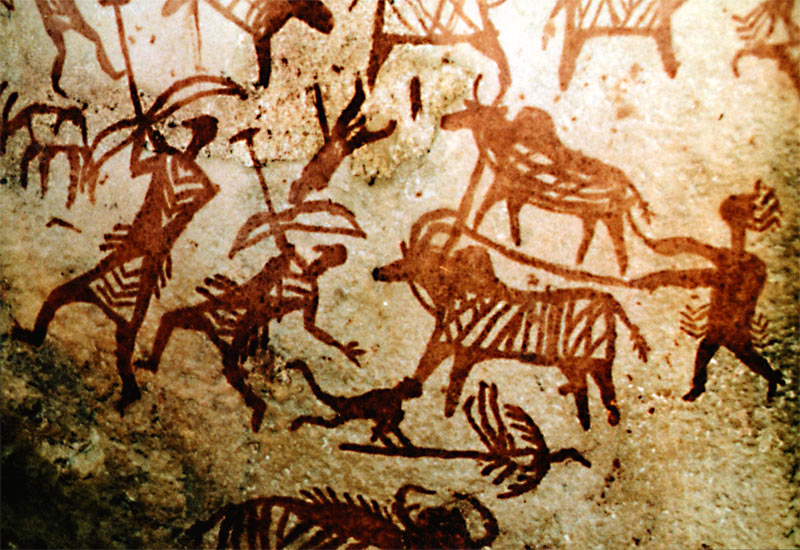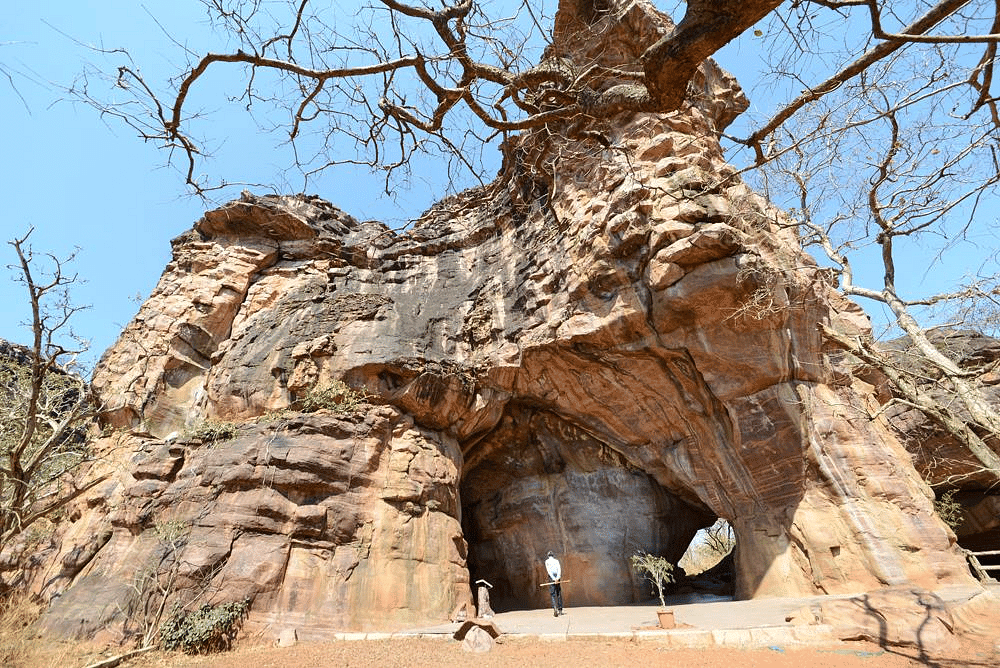Prehistoric Rock Paintings Chapter Notes | Fine Art for Class 11 - Humanities/Arts PDF Download
| Table of contents |

|
| Introduction |

|
| The Upper Palaeolithic Period |

|
| Mesolithic Period |

|
| Conclusion |

|
Introduction
The early stages of human development are often referred to as the Old Stone Age or the Palaeolithic Age.

Discovery of Prehistoric Life
- People long ago didn't have paper, language or books.
- They left behind tools, pottery, and drawings on cave walls.
- Scholars found these items during excavations.
- These discoveries helped experts understand how prehistoric people lived.
Expression through Art
- Basic needs like food and shelter were met.
- People felt the urge to express themselves.
- Painting and drawing on cave walls were some of the earliest ways humans expressed themselves artistically.
Reasons for Prehistoric Art
- Prehistoric people may have painted to make their surroundings more beautiful.
- They also painted to document their daily lives.
- This practice is similar to how some people keep diaries today.
Global Presence of Prehistoric Art
- Prehistoric paintings have been found worldwide.
- While it's uncertain if early humans in the Lower Palaeolithic period made art,
- by the Upper Palaeolithic era, artistic activities were widespread.
Subjects of Prehistoric Art
- Art from the Upper Palaeolithic period often depicted animals, human figures, daily activities, geometric shapes, and animal symbols.
- In India, some of the earliest known paintings date back to this time.
Discovery of Rock Paintings in India

- The first rock paintings in India were discovered in 1867-1868 by archaeologist Archibald Carlleyle.
- India's rock art discovery predates the famous Altamira caves in Spain.
- Early archaeologists like Cockburn, Anderson, Mitra, and Ghosh found many painting sites across India.
Locations of Rock Paintings
- Rock art remnants have been found on cave walls in Madhya Pradesh, Uttar Pradesh, Andhra Pradesh, Karnataka, Bihar, and the Kumaon hills of Uttarakhand.
- Noteworthy sites include the rock shelters along the River Suyal at Lakhudiyar in Almora, Uttarakhand, known for their prehistoric paintings.
Categories of Paintings
- Paintings in these sites typically fall into three categories: depictions of humans, animals (like a long-snouted animal, fox, and lizard), and geometric patterns in white, black, and red ochre colors.
- Human figures are represented in simplistic stick-like forms, alongside various animal motifs and geometric designs.
Characteristics of Rock Paintings
- Paintings often feature wavy lines, rectangles, dots, and scenes of hand-linked dancing human figures.
- There is evidence of superimposed paintings, with black paintings as the earliest layer, followed by red ochre and then white paintings.
Regional Paintings
- In regions like Kashmir, Karnataka, and Andhra Pradesh, Neolithic people used granite rocks as canvases for their art, with famous sites like Kupgallu, Piklihal, and Tekkalkota.
- These sites feature paintings from different historical periods, depicting animals such as bulls, elephants, sambhars, gazelles, sheep, goats, and horses, along with stylized human figures and tridents.
Discovery of Bhimbetka Caves

- The caves at Bhimbetka were first brought to light during 1957-1958 by the renowned archaeologist V.S. Wakankar.
- Numerous additional shelters were uncovered.
- Wakankar dedicated several years to meticulously exploring these remote hills and forests.
- He examined these ancient artworks.
- The paintings found at Bhimbetka encompass a wide array of subjects.
- These include scenes of hunting, dancing, and musical performances.
- Depictions of riders on horses and elephants are also present.
- Animal battles and gathering honey are depicted as well.
- There are representations of body adornment and domestic activities.
Classification of Bhimbetka Art
T
- Rock art at Bhimbetka has been categorized into different groups based on their style, technique, and layering.
- The drawings and paintings are divided into seven distinct historical periods.
- Period I represents the Upper Palaeolithic era.
- Period II corresponds to the Mesolithic period.
- Period III is associated with the Chalcolithic period.
- Following Period III, there are four more phases of art evolution.
The Upper Palaeolithic Period

- Ancient humans drew simple lines and used colors like green and dark red.
- They drew large animals like bisons, elephants, tigers, rhinos, and boars.
- They also depicted stick-like human figures.
- Some of the artworks were wash paintings.
- Most artworks were filled with geometric patterns.
- Green paintings often showed dancers.
- Red paintings typically depicted hunters.
Mesolithic Period
- Period II: Mesolithic Period, characterized by the largest number of paintings
- Paintings are smaller in size with multiple themes.
- Predominant theme: Hunting scenes.

Hunting Scenes
- Depiction of group hunting with barbed spears, pointed sticks, arrows, and bows.
- Hunters shown with traps and snares.
- Hunters adorned with simple clothes, ornaments, head-dresses, and masks.
Depicted Animals
- Includes elephants, bison, tigers, boars, deer, antelopes, leopards, panthers, rhinoceros, fish, frogs, lizards, squirrels, and birds.
- Animals depicted both chasing men and being hunted.
- Some scenes show fear of animals; others show tenderness and love.
Human Figures
- Humans depicted in a stylistic manner; animals in a naturalistic style.
- Women shown both nude and clothed.
- Children depicted running, jumping, and playing.
- Community dances and daily life scenes like fruit gathering and food preparation.
Artistic Techniques
- Colors used: white, yellow, orange, red ochre, purple, brown, green, and black.
- Red from haematite (geru), green from chalcedony, white possibly from limestone.
- Paints made by grinding rocks and minerals, mixed with water and sticky substances like animal fat or gum.
- Brushes made of plant fiber.
- Colors survived due to chemical reactions with the rock surface.
Rock Shelter Paintings
- Paintings found on walls and ceilings of rock shelters, both living spaces and potentially religious sites.
- Some paintings are high up on rock shelters, visible from a distance.
Quality and Themes
- Paintings retain pictorial quality despite limitations.
- Scenes depict adventurous men and majestic animals.
- Artists had a passion for storytelling, depicting dramatic survival scenes.
Superimposition
- New paintings often created over older ones, sometimes up to 20 layers.
- Possible reasons: dissatisfaction with previous work, sacred places, or use by different generations.
Significance
- Provides insights into early human lifestyle, food habits, daily activities, and mindset.
- Witness to human civilization evolution through tools, ceramics, and bones.
- Rock paintings are a valuable legacy of prehistoric human beings.
Conclusion
In conclusion, the prehistoric rock art of India is an important part of our cultural heritage. It offers a glimpse into the lives and beliefs of our ancestors and reminds us of the enduring human impulse to create and express ourselves through art.
|
10 videos|24 docs|16 tests
|
FAQs on Prehistoric Rock Paintings Chapter Notes - Fine Art for Class 11 - Humanities/Arts
| 1. What is the significance of prehistoric rock paintings in understanding early human civilizations? |  |
| 2. How were prehistoric rock paintings created and preserved for thousands of years? |  |
| 3. What are some of the common themes depicted in prehistoric rock paintings? |  |
| 4. How do archaeologists and researchers study and interpret prehistoric rock paintings? |  |
| 5. What are some of the famous prehistoric rock painting sites around the world? |  |
















